'White elephant': The €2.7m transport training centre causing conflict in disability community
Disabled people feel that once again they were not consulted about a major project that most affects them.

“THE FUNDAMENTAL FLAW is that the funding was committed to, without any engagements with disabled people. It’s not in keeping with ‘nothing about us, without us’ at all. It contradicts that and flies in the face of it.”
Elaine Howley is one of a number of disability advocates and disabled person’s organisations who are adamantly against €2 million in Government funding being allocated to a transport training centre for disabled people, saying that they were not consulted and that the funding could have been better spent on other more impactful initiatives.
Concerns about the National Transport Training Centre, recently rebranded as the Wayfinding Centre and which is spearheaded by the National Council for the Blind of Ireland (NCBI), have been raised numerous times since then Minister for Transport Shane Ross surprised the chamber with its announcement at an Oireachtas Joint Committee in June 2019.
Under the UN Convention on the Rights of People with Disabilities (UNCRPD), the voice of disabled people should be prioritised, according to Howley.
“It is a significant amount of money that could be put into responding to the needs that people actually have. A big building in Dublin is not what people need or want,” she said.
The vision-impaired advocate sits on the Government’s Disability Stakeholder Group and is their representative at the Department of Transport’s Accessibility Consultative Committee (ACC). She is also a board member of Dublin Bus and the NCBI’s former director of policy and advocacy.
Chris White, chief executive of the NCBI, told Noteworthy that “the Wayfinding Centre is an important project to provide a dedicated and safe training space for people with disabilities and those with reduced mobility”.
“Providing training in mobility skills to persons with disabilities and to specialist staff working with persons with disabilities” is part of the UNCRPD which was ratified by Ireland in 2018. Everyone that Noteworthy spoke to agreed on one thing – that transport training is vital.
If that is the case, what is causing such conflict within the disability community?
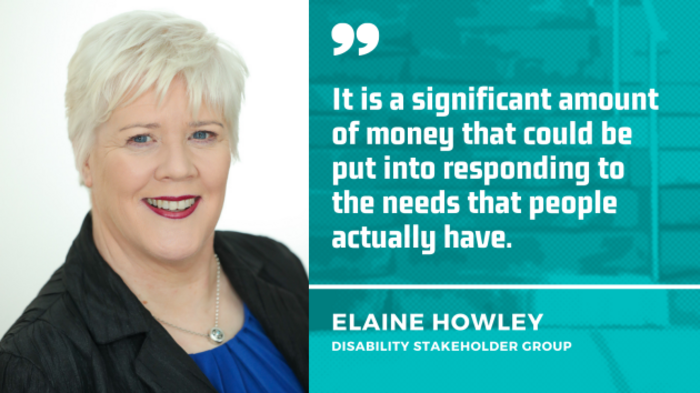
At Noteworthy, we investigated accessibility of public transport over the past few months. Concerns about transport training, in particular the development of the Wayfinding Centre, were raised by numerous disabled people and advocates both on and off the record.
From documents obtained through Freedom of Information (FOI) requests and press requests to over 20 disability organisations as well as transport and other bodies mentioned in these, we can now reveal:
- Both the National Transport Authority (NTA), who are providing €2 million in funding for the project, and the Department of Transport were aware that other disability organisations had not been consulted prior to the announcement of the Centre by the Minister Shane Ross.
- The NCBI told Noteworthy they would have liked to complete “further consultation” before the project entered “the public domain”. Meanwhile, the NTA are “satisfied that the NCBI “engaged extensively with other disability groups at the appropriate time”.
- Concerns about the project have been raised numerous times at the Department of Transport Accessibility Consultative Committee. Lack of consultation, the need for a Centre and its location as well as the volume of funding were among the issues raised.
- The capital cost of the Centre was estimated at €2.7 million last November, with an annual operating cost of up to €500,000 annually. The NTA has provided over €300,000 of their grant to date. Additionally, Transport Infrastructure Ireland has ordered a LUAS “tram module” at a cost of €100,000 for the Centre.
- Dublin City Council was to contribute “capital funding”, according to an NTA briefing to the Minister last November, but told Noteworthy it is “not involved in funding this building”.
- A number of disability organisations who provided letters of support for the project told Noteworthy they haven’t received any update about it from the NCBI in over 18 months. Other organisations who were listed as supporters by the NCBI and NTA no longer support the project, or never did so.
- Many advocates are worried that the mooted expansion of a training programme, the Travel Assistance Scheme, supported by all groups Noteworthy spoke to, will be impacted by the Centre, though the NTA state it “is not an alternative to that scheme”.
This is the second part in the LIFT OUT series of articles by Noteworthy on public transport accessibility which will be published over the coming weeks. Last week, part one found disabled people were ‘on tenterhooks’ trying to access taxis.
***
Disability groups ‘not aware of proposals’
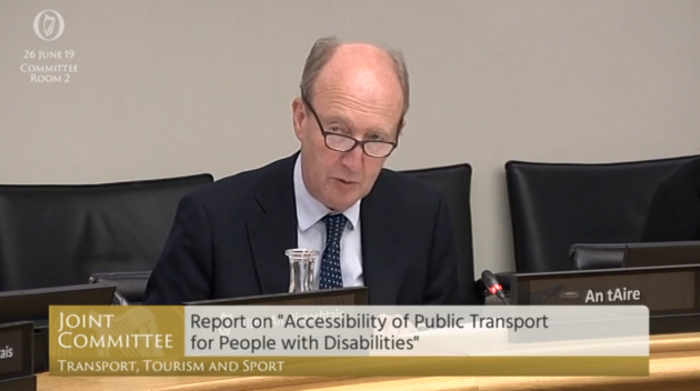 Shane Ross, then Minister for Transport, announcing the Centre's funding to the surprise of most.
Shane Ross, then Minister for Transport, announcing the Centre's funding to the surprise of most.
The first that most disabled people and those in the disability sector heard of this project was when then Minister for Transport Shane Ross was invited to a meeting of the Joint Committee on Transport to report on the implementation of the Committee’s ‘Accessibility of Public Transport for People with Disabilities’ report.
He announced the NTA funding for a National Transport Training Centre and said “the primary goal of the training centre is to provide short-term comprehensive instruction designed to teach people with disabilities how to travel safely and independently using public transportation”.
The Centre would include “full-size replicas of bus, train and tram vehicles… to familiarise users with how to safely and confidently use these modes every day”. He also stated that training would be extended to transport agency staff and other key stakeholders.
That was on 26 June 2019, with a press release issued by the Department of Transport (DOT) on the same day. Correspondence between the NTA and the Department of Transport in the lead up to this announcement, obtained by Noteworthy via FOI, shows that both were aware of the lack of consultation with disability groups prior to the announcement.
The day before this, in an email to finalise the press release from a DOT official to Hugh Creegan, Director of Transport Investment and deputy chief executive of the NTA, the Department official asked if the NCBI had been consulting disability groups such as the Irish Wheelchair Association (IWA) on the Centre.
The morning of the Minister’s announcement, Creegan replied: “Groups like the IWA and others have not been involved to date and are not aware of the proposals.”

This absence of consultation before funding was committed was a key issue for disabled people Noteworthy spoke to. This was raised as an issue at the first meeting of the DOT’s Accessibility Consultative Committee after the announcement in September 2019, with the minutes noting:
“The representatives of the disability organisations at the meeting stated that no consultation had taken place with their organisations.”
The Accessibility Consultative Committee consists of disability organisations, members of the Government’s Disability Stakeholders Group and key agencies under the Department of Transport, such as the NTA and Transport Infrastructure Ireland (TII).
Since the announcement, the Centre has been discussed, with concerns raised, in four out of the six Accessibility Consultative Committee meetings that have taken place.
When asked if the NCBI regrets not consulting organisations before this, a spokesperson said: “Ideally, it wasn’t NCBI’s intention to enter the public domain [at that time] given the infancy of the project concept”.
They added that they “would like to have completed further consultation with the wider sector and its stakeholders, and to complete the process of identifying a suitable site”.
Noteworthy also put this to the NTA who said that “the developer of the project is NCBI”. The spokesperson said that “the NTA is satisfied that they have engaged extensively with other disability groups at the appropriate time”.
In response to this query, a spokesperson for the DOT said that “stakeholder consultation is of course vital to ensure the centre meets the needs of all its users”, and added:
“The NCBI has confirmed to the Department its intention to consult with all necessary stakeholders throughout the process, with a stakeholder engagement plan to capture all views. The NCBI advised that it will target expressions of interest from disability stakeholders in the development of an advisory group as well.”
This “dedicated Transport Advisory Group will be established to take advantage of the opportunities in terms of innovation, education, training and customer engagement that the Centre will offer”, according to the NCBI spokesperson.
Originally limited to vision-impaired people
 Slide from the NCBI presentation to the NTA in 2018 showing photos from the Australian Centre.
Slide from the NCBI presentation to the NTA in 2018 showing photos from the Australian Centre.
The NTA spokesperson stated that the “Centre was a proposal brought forward by the NCBI who sought grant assistance towards its development”. This happened in 2017, according to a Minister’s briefing note obtained via FOI, and the proposal was for a Centre for vision-impaired people “to safely access and use public transport”.
The NCBI referred to two other Mobility Training Centres when presenting the idea to the NTA – one in Melbourne which cost $500,000, run for vision-impaired people by Vision Australia, and one in Las Vegas which cost $5.4 m, which has programmes for older people and schools.
The same briefing note stated that in July 2018, the NTA told the NCBI it “would be prepared to grant aid the delivery of a NTTC [National Transport Training Centre] if the training faculty was open to other groups with disabilities”. This was almost a full year before the Joint Committee announcement.
Following this, the NCBI asked the Disability Federation of Ireland (DFI), of which the NCBI is a member, to host a meeting to present the model. John Dolan, chief executive of DFI said that this happened in January 2020, “after they had gone way down the road with it”.
“That consultation didn’t consolidate their enthusiasm for the project. Quite the opposite. The concern wasn’t about the detail. The concern was the concept.”
Dolan wrote to the NTA’s Creegan following this meeting, in a letter Noteworthy obtained via FOI:
Contributions were not given sufficient, and in some cases no response… Many organisations, including DFI, with a strong interest in people being able to access and use public transport safely and comfortably are not convinced, to put it mildly, as to the capacity of this proposal to meet its objectives in an efficient and effective manner.
Noteworthy spoke to a number of people who attended the meeting in DFI and they all have similar assessments of the response to NCBI’s presentation. “It’s not what people wanted on the ground”, said Joan Carty, national advocacy officer at the Irish Wheelchair Association (IWA). “Not one person in the room was in favour of it,” recalled Howley.
‘You can’t learn in abstract’
 Robbie Sinnott of Voice of Vision Impairment feels that training on local routes is the best way to learn.
Robbie Sinnott of Voice of Vision Impairment feels that training on local routes is the best way to learn.
“It’s outrageous that we were not consulted,” according to Robbie Sinnott, chair of Voice of Vision Impairment, the only disabled person’s organisation for vision-impaired people in Ireland. “This is not just an NCBI issue. This is the State paying €2 million for a private organisation to run this.”
Among other things, Sinnott is concerned that millions are being spent on an artificial environment as he said that in-situ training with “background noises going on” is the best way to learn.
Cars are cues, people are cues, everything is an audio cue. You can’t learn in abstract. It would be like learning computer theory without ever having a computer.
“The whole concept is barking mad”, he added, calling the Centre a “white elephant”.
Gary Kearney, accessibility advocate and presenter on Dublin City FM, was in the Oireachtas chamber for the announcement. He has been campaigning for improved public transport for a number of years following a traumatic brain injury.
The advocate was shocked by the NTA’s funding decision for similar reasons to Sinnott. “Everyone knows the best training for everybody is real-life experience.” This was a view that was shared by many people Noteworthy spoke to. Kearney added that “everyone in the Disability Thematic Group [of the Dublin City Public Participation Network] was completely against it”.
“It’s not a constructive way to help people learn how to use public transport,” explained IWA’s Carty. “From talking to our members, it’s definitely something they don’t feel would benefit them.”
We did focus groups with our membership across the country, and what was coming back was that they needed somebody in their area so that they could get used to their own journeys to college, employment, socialise, go shopping. To build their confidence that way.
A scheme based on people’s local travel routes is already in place and run by Dublin Bus. Over the course of this investigation, the travel assistant Roger Flood, who helped set up this scheme was praised continuously by the entire disability community. “We need more Rogers,” was a regular phrase heard by Noteworthy over the past few months.
The Travel Assist Scheme has provided over 9,000 “travel assists to help people travel independently” over the past 12 years, according to a Dublin Bus spokesperson.
“It’s exactly [what] needs to be replicated across the country,” according to Carty. “That’s where the funding needs to go if this is for people with disabilities first and foremost.”
Noteworthy put this concern to the NTA and asked if they felt it had been adequately addressed. They said that the NCBI “identified the need for specific training support for people with visual impairments, including the fully blind, to be able to confidently and independently use the overall transport system in Ireland”.
They added that the Centre is “complementary to the Travel Assistance Scheme and is not an alternative to that scheme”.
The NCBI spokesperson echoed this and stated that they “have been given an assurance that NTA investment is designed to be complementary and additional to existing programmes in place, and specifically to the Travel Assistance Scheme, which has been critical in providing the necessary compensatory skills to many blind and vision-impaired people to live a life of their choosing”.
These reassurances don’t convince Carty who is concerned about the future expansion of the Travel Assist Scheme. “While they’re saying it’s not going to impact the funding, we’re not seeing any extra funding to expand it around the country.” Funding for both the Centre and this scheme fall under the Accessibility Programme.
The NTA “is currently examining the feasibility of extending the Travel Assistance Scheme to other counties,” according to chief executive Anne Graham last month in an answer to one of a number of parliamentary questions (PQs) on transport accessibility put to the Minister by Social Democrat TD Holly Cairns.
More than €100,000 was provided for this scheme in 2018 and 2019, but this dropped to under €70,000 in 2020. However, the NTA told Noteworthy that it “allocated in full” the money requested last year.
A spokesperson for Dublin Bus said that “the scheme has not received any funding increases or cuts” in 2020 or this year. “The scheme was temporarily on hold due to Covid-19 but has been back assisting customers since June 2021.”
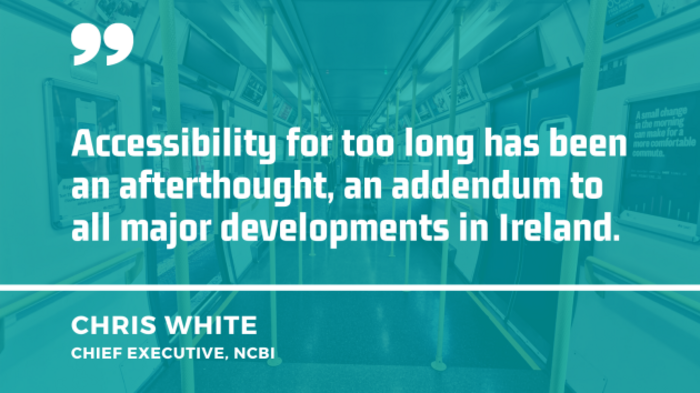
Both the NCBI and NTA emphasise to Noteworthy that the Wayfinding Centre would have uses beyond training disabled people. The NCBI’s White said “a core objective… will revolve around assisting professionals responsible for the built environment and our transport networks to understand the concepts and needs of people with disabilities”.
“The Wayfinding Centre through its academic partnerships in conjunction [with] the construction and design professional bodies aims to bring accessibility to the beginning of the conversation.”
Dublin-centric concerns
DFI’s Dolan was a senator at the time and also in the Committee chamber in June 2019. He initially welcomed the announcement mainly because it was an initiative “rather than the Minister having to be encouraged to do something”.
However, when he looked at the details, he realised it was a “static” premises being funded. Dolan worked with the Irish Wheelchair Association to provide driver training previously and his stance on the project is guided by this experience.
“If you could only give training to people who could actually get to your centre, that was a major blockage for a lot of people. Over time, we adapted so we could bring the driver tuition closer to people. That informed my whole thinking on this. How does someone get from Clare, Galway or Monaghan to Dublin, and then get out to the particular centre?”
Sinnott felt “it may as well be on the moon” as “if it was in Connolly or Heuston, people would have to get a train to learn how to use a train”.
The Centre being “Dublin-centric” was also noted in a number of Accessibility Consultative Committee meeting minutes and in response to concerns, the NCBI told the Committee in November 2020 that “40% of the population live in the Greater Dublin Area” and “the chosen location is well connected to public transport”.
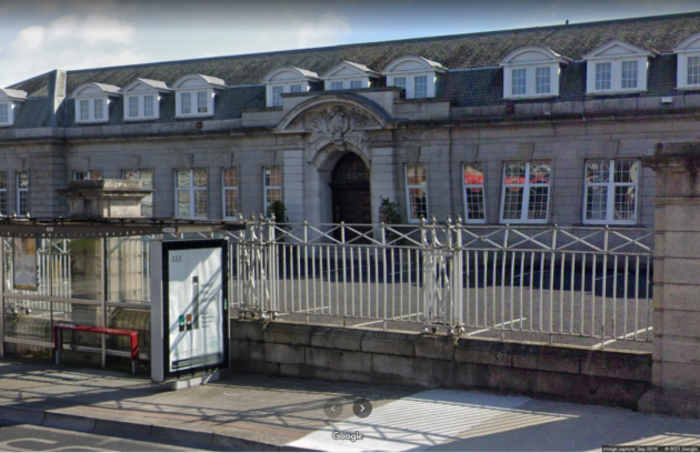 The railings, gates, piers and plinth walls are protected on the former Smurfit Kappa printworks.
The railings, gates, piers and plinth walls are protected on the former Smurfit Kappa printworks.
Planning permission was submitted for the Centre recently which showed it is to be located in Botanic Business Centre, the site of the former Smurfit Kappa printworks and before that, a tobacco factory, on Botanic Road in Glasnevin. It is co-located with the NCBI’s Day Services.
The lease has been signed and is being provided at below cost by Smurfit Kappa Group, according to NTA meeting minutes, obtained by Noteworthy. The group was offered naming rights by the NCBI following this, according to the minutes, but did not take them, instead suggesting the tagline: ‘Proudly supported by the Smurfit Kappa Group’.
A spokesperson for Smurfit Kappa Ireland said that “any commercial arrangements are confidential” when we inquired about this.
When Noteworthy examined public transport links from the Centre, we found that if disabled people were coming from either Heuston or Connolly Station or Busáras by public transport, at least two bus connections (or a bus/LUAS combination) or a 1.3km walk to Drumcondra train station is required.
When this was put to the NCBI, a spokesperson said that “accessible parking will be available onsite and a shuttle to key public transport interchanges will be available by arrangement”.
We do not envisage people undertaking complex public transport journeys as indicated to access the centre independently. Users of the centre will be supported by mobility experts.
This 100-year-old building with a number of protected structures requires planning for some modifications including access ramps. Earlier this month, planners requested additional information including an “analysis of the historic building and curtilage” carried out by a conservation architect.
Noteworthy asked the NCBI if they envisaged this analysis and the age of the building which includes protected structures would add cost to the project. A spokesperson said that no major changes to the “fabric of the building or the protected structure” are being made.
“The protected elements of the premises do not negatively impact on the costs or on the future use of the premises as we plan to work within the confines of the existing building.”
Finding funding
The NCBI are “addressing all avenues of possible support funding”, according to a spokesperson. They did not provide Noteworthy with the current estimated cost, but said “the final price becomes certain when the tender process has concluded”.
It is also unclear what the latest estimate is. In their presentation to the DOT Accessibility Consultative Committee in November 2020, it was noted in the minutes that the cost was €2.4 million. However, six days earlier the NTA told the Minister in a briefing note that they were advised by the NCBI that estimated the capital cost was €2.7 million.
The NCBI did not respond directly when asked about this discrepancy, but a spokesperson said it “currently works to a projected budget prepared by professional advisors” and “will be putting in funding of its own”, on top of the initial grant offer of up to €2m from the NTA which “is dependent upon the project reaching agreed stages of development”. The NTA has provided over €300,000 of their grant to date.
The annual operating cost was estimated to be around €400,000 to €500,000 at the same presentation to the ACC, which is “expected to be matched by income”, according to the minutes.
When asked how they plan to match this cost, the spokesperson said “the operating costs are actively being considered by NCBI”, and added that they “have no intention in placing service charges on persons with disabilities in utilising the space”.
Dublin City Council was to contribute “capital funding”, according to the NTA briefing to the Minister last November, but told Noteworthy it is “not involved in funding this building”.
According to NTA minutes of meetings with the NCBI, they are also approaching the Immigrant Investment Programme (IIP), an initiative that allows investors from non-European Economic Area to obtain visas to study, work and live in Ireland.
Additionally, a LUAS tram unit is being provided by Transport Infrastructure Ireland. The NTA spokesperson also stated that “Dublin Bus, Irish Rail and Bus Éireann have agreed in principle to provide specimen vehicles”.
Transport Infrastructure Ireland has already ordered a LUAS “tram module” at a cost of €100,000 for the Centre “on foot of a request last year by the NCBI Board”, according to a spokesperson. “The actual cost benefits from the fact that Alstom (the tram’s supplier) is providing the module at a reduced cost as part of their commitment to Corporate Social Responsibility.”
A spokesperson for Bus Éireann said they had a meeting in the “concept development stage” but has not been requested to provide vehicles to the Centre “as yet”. Dublin Bus directed Noteworthy to the NTA for comment.
Iarnród Éireann had initial discussions with NCBI in 2019 when the concept was being developed and agreed in principle, according to a spokesperson.
Our understanding is that the project has not progressed significantly. We will engage with the NCBI further as the project progresses.
According to documents obtained by Noteworthy, the NCBI also met with the Irish Aviation Authority (IAA). When asked if the IAA are providing the NCBI with any equipment, a spokesperson said it’s “current financial position resulting from the impact of the Covid-19 pandemic means that there is currently no expenditure on non-core items”.
The cost of the Centre was raised by a number of disabled representatives that spoke to Noteworthy and was noted in the Department’s ACC meeting last July: “It was stated that neither the NTA nor the NCBI were listening to feedback, including that the project was a waste of money. It was stated that these concerns would not be going away.”
NCBI’s role as a service provider was brought up as a concern at an ACC meeting. A letter from the Dublin City PPN Disability Thematic Group to the NTA, obtained by Noteworthy through FOI also stated that they had “serious concerns” that “public funds would be used to fund such a centre, which is proposed to be owned, managed and controlled by a single NGO”.
Howley, who is on the ACC, said that “any organisation building a facility to meet the needs of other groups that might not be in their area of expertise…should prioritise listening to the voice of disabled people and finding out from them what [is] required in relation to public transport”.
“For instance NCBI has advised lots of different bodies on how to make buildings and environments accessible for people with impaired vision. Their expertise isn’t in the area of wheelchair access, for example.”
Support for the Centre
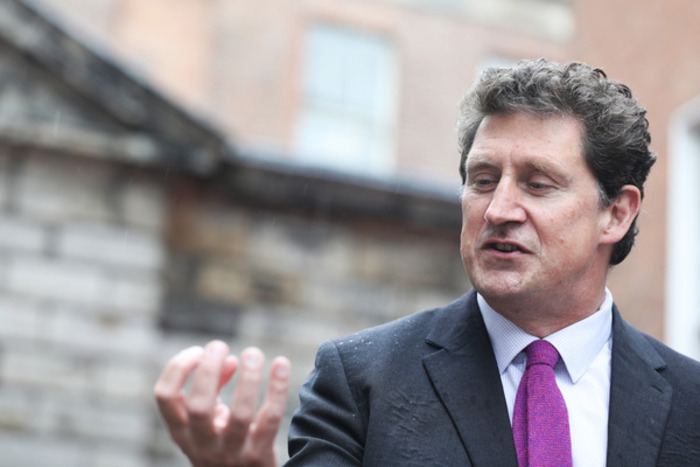 Minister for Transport Eamon Ryan obliged the NCBI's request for a letter of support earlier this month.
Minister for Transport Eamon Ryan obliged the NCBI's request for a letter of support earlier this month.
Since the announcement in 2019, the NCBI has been working on building support for the project. Last month, in an email obtained by Noteworthy, their chief executive, White, wrote to Minister for Transport, Eamon Ryan, with a template letter of support for him to sign and said “it would be hugely helpful if the Minister was able to sign off the following statement”.
The Department of Transport provided Noteworthy with a copy of the subsequent letter sent by the Minister in mid-July.
A spokesperson for the DOT said that the Minister “is very supportive of initiatives which contribute towards making public transport more accessible”. They added that “in that context, the Minister was pleased to confirm his support for the Wayfinding Centre”.
Noteworthy analysed the contents of the template “statement” and letter the Minister sent back to the NCBI and much of proposed wording was kept. Here is the paragraph with the most similarities:
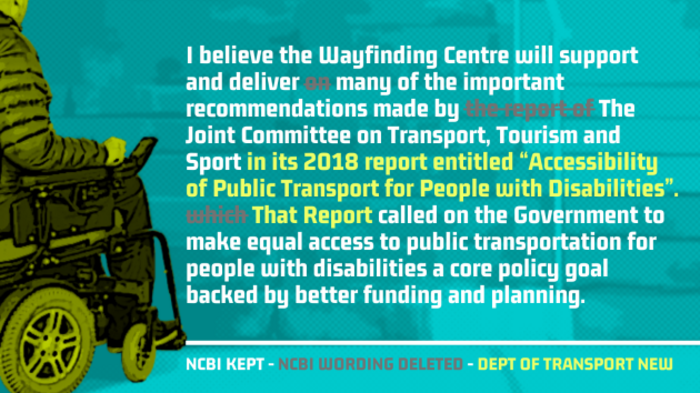
To view a readable version of our analysis of the full letter of support, click here.
The NCBI also had discussions with a number of disability organisations to obtain letters of support towards the end of 2019 and start of 2020. We obtained copies of these letters from the DOT via FOI. They were mainly from disability-related organisations, with two additional letters from housing bodies and one from TU Dublin.
Noteworthy contacted every disability-related organisation – 12 in total – that was either identified as providing a ‘Statement of Support’ in DOT documentation obtained by Noteworthy or had given a letter of support to the NCBI. View the full responses from these organisations here.
Ten responded to our press requests. The Children’s Rights Alliance and Dyslexia Association of Ireland, who both provided letters of support, told Noteworthy that they haven’t received any update about the Centre from the NCBI in over 18 months. Ava Battles, chief executive of MS Ireland said that they supported the project “at the time but with Covid etc. we have not reviewed this”.
Five of the organisations – Age & Opportunity, Chime, Family Carers Ireland, Stewarts Care and Enable Ireland said they continue to support the project, with Enable Ireland adding the caveat that “it should in no way be seen as an alternative to the investment needed from Government to make public transport fully accessible [or] a replacement for the real world experience of using public transport”.
Age & Opportunity, which promotes positive aging, said that they were “delighted to participate in a focus group on the issue” and “continue to be very supportive of the project”.
A spokesperson for Chime, which provides services for deaf and hearing-impaired people said it “broadly supports initiatives that promote accessibility for people with disabilities” and “as a country we need to do more”.
Brendan O’Connor, chief executive of Stewarts Care, which provides services for people with intellectual disabilities, said that the Centre “assists in addressing the gap between a person’s ability and public service delivery/accessibility”.
When asked if he was aware of concerns about it, he said that he wasn’t but he appreciates “that change can be challenging and that it is almost impossible to reach a satisfactory level of engagement and consultation with all interested stakeholders in a project as impactful as this”.
Two organisations – Headway Ireland and the Irish Wheelchair Association – who were listed in a PQ response by the NTA from July 2019 as having had discussions with NCBI as well as in NTA correspondence obtained via FOI from September 2019 as providing ‘Statement of Support‘ to NCBI – are no longer supporting the project, or never did so.
Headway Ireland, who provides services to people with an acquired brain injury, told Noteworthy it “did enter into exploratory discussions, but following a consultation with our client group, opted not to support the project”.
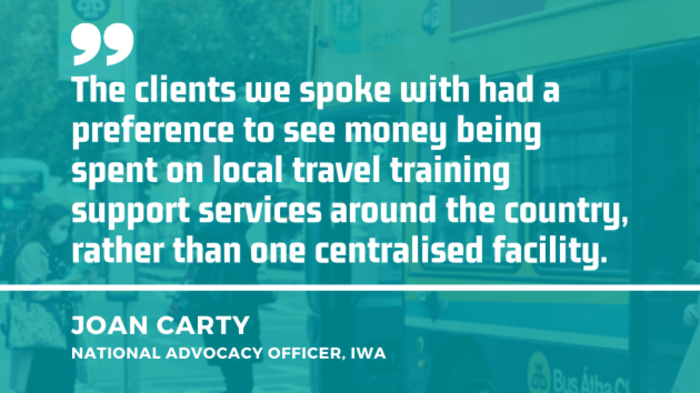
The Irish Wheelchair Association never gave their support to the project, according to Carty.
When the NTA’s Transport Accessibility Manager informed a DOT official that the NCBI listed the IWA as providing a “statement of support” in September 2019, the Department’s response was: “It would be interesting to know who in IWA they have received a statement of support from.”
Its chief executive Rosemary Keogh wrote a letter to the NTA following their PQ in 2019 which stated:
“The IWA has had no involvement or consultation with the NCBI in relation to this training centre and would appreciate it if you could bear this in mind when communicating information to interested stakeholders.”
The NCBI spokesperson said that “a variety of disability organisations have been consulted in relation to this project and NCBI [continues] dialogue in this vein in an open and cooperative manner”. They added that they “welcome the involvement of organisations of persons with disabilities”.
‘Decisions are made and then engagement happens’
Carty felt “it goes back to the very thing people with disabilities have been saying for years – involve us in the consultation process from the beginning and [have] meaningful consultation”.
She said “it is clear that this didn’t happen” for the Wayfinding Centre. “Organisations weren’t involved, and more importantly, people with disabilities weren’t involved from the beginning.”
It happens over and over again, where plans are made and then people with disabilities are brought in. It’s said that it’s consultation but in actual fact it’s merely trying to rubber stamp things.
Carty said that this is the reason that disabled people are frequently unhappy with decisions; because “they’re not consulted from the get go”.
Sinnott strongly felt that the State needs to stop treating service providers like they are representative organisations. For example, none of the organisations that have publicly supported the Centre are disabled persons’ organisations (DPOs).
DPOs are distinguished by being “led, directed and governed by persons with disabilities”, according to the UN Committee on the Rights of Persons with Disabilities.
In comparison organisations that provide services or advocate for disabled people, cannot be representative organisations. The Committee stated that this activity “may result in a conflict of interests in which such organisations prioritise their purpose as private entities over the rights of persons with disabilities”.
Howley, who is vision-impaired, uses the recent change from yellow bus stop poles on much of Dublin’s streets stops to stainless steel poles as an example of not being heard. “I go to places I don’t know [and] the only way that I can find the bus stop at the moment is that it is yellow.”
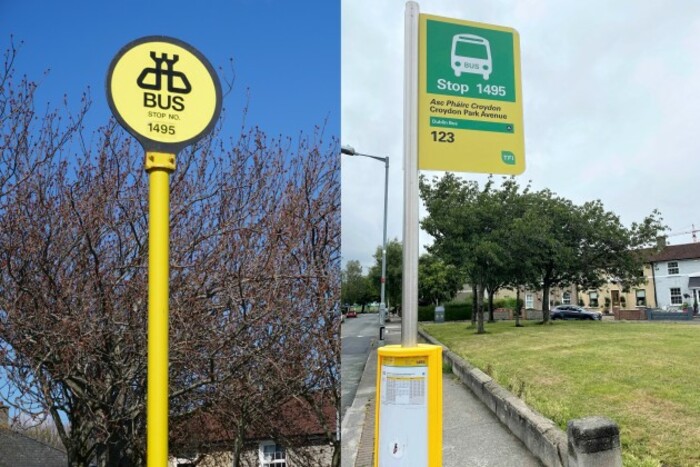 Yellow bus stop in Marino, Dublin, since replaced with stainless steel version.
Yellow bus stop in Marino, Dublin, since replaced with stainless steel version.
The advocate explained when people with low vision navigate the world, they look for cues. For a bus stop, she used to look for a yellow cue. “It only works because it stands out from the surrounding area where, in our country, a lot of things tend to be grey.”
She said she raised this “on numerous occasions” but “decisions are made and then engagement happens”.
Kearney has also raised this with the NTA. He explained that “when you have a brain injury or intellectual disability, it’s all about patterns”. He added that “it’s all about simplicity [and] trying to find a silver pole is confusing”.
“When you get knocked off your pattern, the anxiety and panic sets in. When you run down a hill and your legs go faster than you want; that’s your brain. It’s all about consistency.”
He said that “the NTA say they have consulted with us, but they didn’t… they tell us, we say no and they do it anyway”.
A spokesperson for the NTA said the poles in question are made of stainless steel, but have large yellow/green signs at the top and yellow carousels in the centre of the pole, both for visibility.
They added that “the new single style of bus stop is intended to be used for all Transport Operators nationwide instead of the current uncoordinated selection of red, chrome, grey and yellow poles with differing coloured head plates and varying information levels”.
“One of the issues with current bus poles is corrosion.” To avoid this, “it was considered prudent to move to a stainless steel type of pole which doesn’t rust or become structurally weaker due to weathering”.
However, Kearney felt that cost was being put ahead of accessibility by the NTA on this issue, and yellow poles should have been accommodated.
‘More time, money and stress’
“Retrofitting – and that’s right across the board from transport to housing – could all be avoided if we consult properly and plan from the very beginning,” according to Carty, who added that IWA members recently viewed a number of new bus models in order to give feedback to the NTA.
The buses “are being ordered before we’re being asked,” she said, but added that Covid didn’t help with that. There have been improvements in recent years, she said, “but there is a long way to go before people with disabilities are heard and catered for”.
The NTA provided a list of buses ordered since 2019 to Noteworthy, as well as comments on modifications needs for accessibility.
Modifications were needed on 102 single deck coaches which included more turning space for a wheelchair and 89 buses were put on hold for two years, following modifications that had to be re-reviewed by the IWA. A spokesperson for the authority said:
This was a good example of where a particular issue was brought to the attention of the National Transport Authority and where the Authority addressed and resolved the matter as quickly as possible.
We put it to the NTA that numerous disabled people told us they are only asked for their views after decisions are made. However, no further response was given by the spokesperson. The NTA did say that a User Group with disabled people is expected to be “established later in the year”.
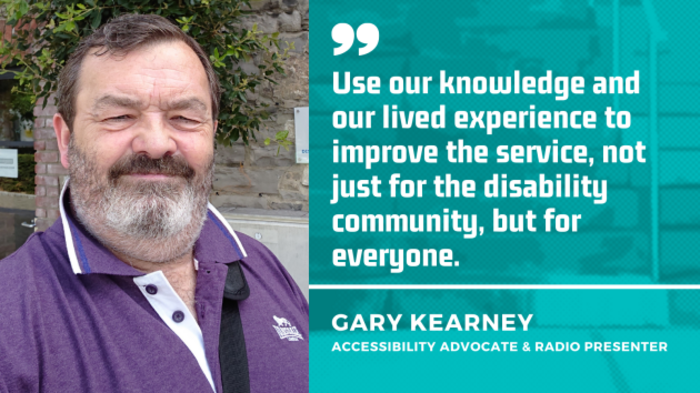
In contrast to the NTA, Kearney pointed out positive experiences of early engagement he had with Irish Rail and Dublin Bus who, he said, include disabled people from the start.
“When you’re not included from concept, you’re in a position where you have to fight a battle. It’s counterproductive. It’s financially stupid. It costs more time, money and stress.”
He added that disabled people “are the most ingenious people you will meet” as “we spot things in an instant that designers, engineers, architects don’t spot”.
“We’re the best beta testers there are. Use our knowledge and our lived experience to improve the service, not just for the disability community, but for everyone.”
***
This is the second part in the LIFT OUT series of articles by Noteworthy on public transport accessibility which will be published over the coming weeks. Last week, part one found disabled people were ‘on tenterhooks’ trying to access taxis. For this project, we also teamed up with The Journal as part of this month’s deep dive into transport as part of The Good Information Project.

This investigation was proposed and part-funded by readers of Noteworthy, the investigative journalism platform from The Journal, and carried out by Maria Delaney.
This work is also co-funded by Journal Media and a grant programme from the European Parliament. Any opinions or conclusions expressed in this work is the author’s own. The European Parliament has no involvement in nor responsibility for the editorial content published by the project. For more information, see here.







